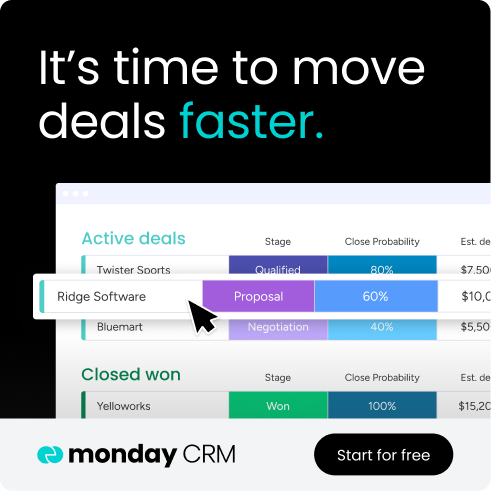Hitting sales targets consistently requires more than just great reps. It demands a predictable, repeatable playbook that turns leads into closed deals. A well-defined sales cycle provides the structure needed to move opportunities forward, and creates the alignment and visibility needed to hit your numbers.
This guide breaks down that foundational framework. We will walk through the seven essential stages every deal moves through, from finding leads to closing the sale and nurturing the relationship.
You will also learn how to measure your cycle’s length and manage the entire process for faster, more consistent results. Understanding these stages transforms sales from an art into a science. Let’s dive in.
Try monday CRM
Key takeaways
- A sales cycle is your repeatable roadmap that transforms prospects into customers through seven distinct stages: prospecting, connecting, qualifying, presenting, resolving objections, sales closing, and following up.
- Understanding your sales cycle length and stage-by-stage conversion rates enables accurate forecasting and helps you identify exactly where deals get stuck or fall apart.
- Short sales cycles work for simple, low-value transactions with few decision-makers, while long cycles are necessary for complex, high-value solutions involving multiple stakeholders.
- Smart sales cycle management combines real-time tracking, automation, marketing alignment, AI assistance, and continuous training to close more deals faster without sacrificing relationship quality.
- monday CRM ‘s AI capabilities and customizable workflows adapt to your unique sales approach, providing the visibility and automation needed to accelerate results while maintaining the human connections that drive sales success.
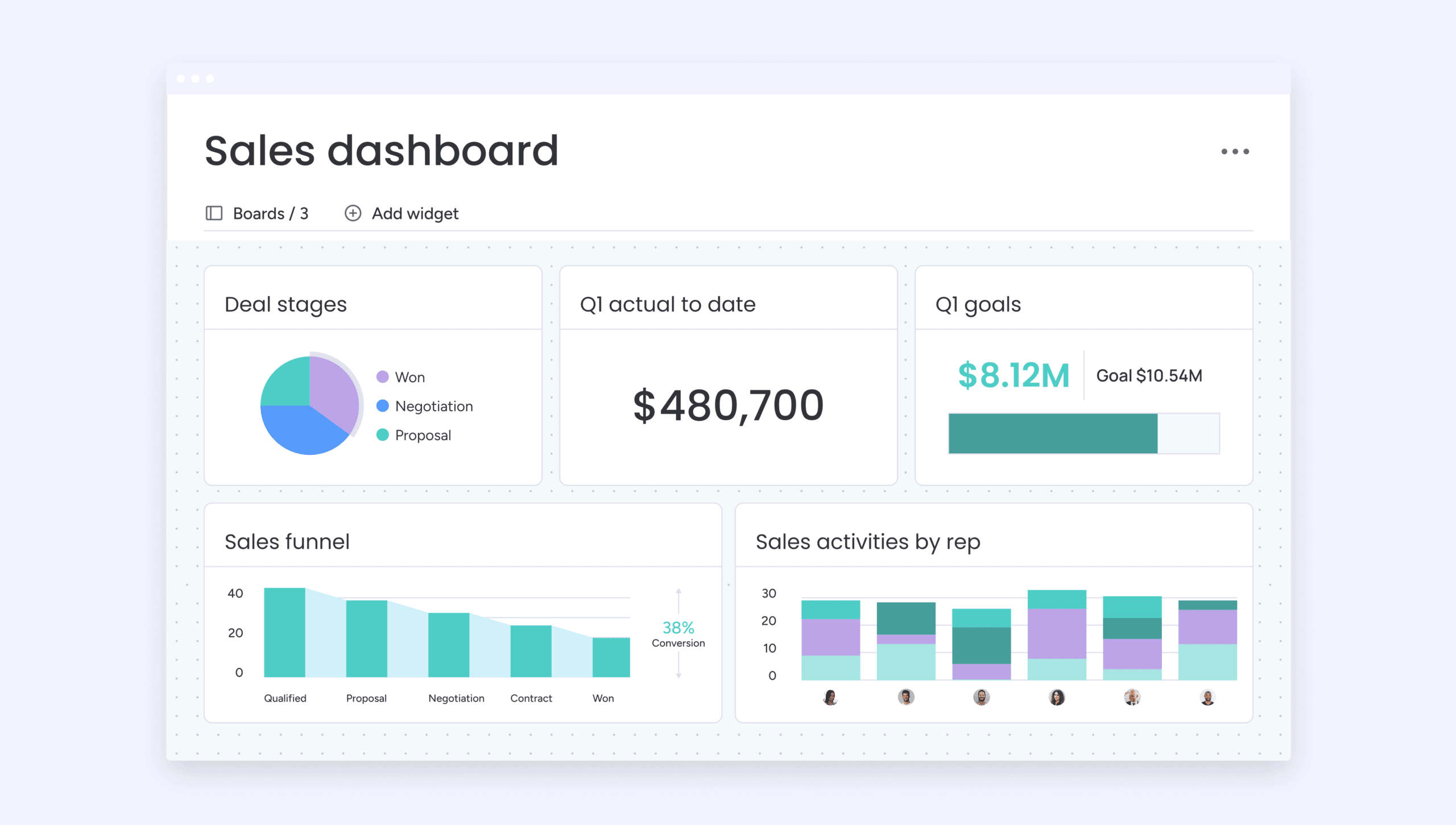
What is the sales cycle definition?
A sales cycle is the repeatable series of steps your team follows to turn a prospect into a paying customer. This means tracking every interaction from first contact through final purchase, giving you a roadmap for consistent sales success.
The sales cycle focuses on the specific stages prospects move through, while a sales process covers your overall sales methodology and strategy. One tells you where to go, the other tells you how to get there.
Why does the sales lifecycle matter?
The reason some sales teams consistently hit their targets while others struggle often lies in how well they understand and manage their sales lifecycle.
A defined lifecycle transforms guesswork into predictable results. You’ll know exactly how many prospects typically convert at each stage, making accurate forecasting possible for the first time.
New sales reps get up to speed faster when they have a proven framework to follow. Instead of figuring things out through trial and error, they can learn from what already works.
Most importantly, you’ll spot exactly where deals get stuck. Maybe prospects go silent after demos, or perhaps contract negotiations drag on forever. monday CRM helps you visualize these patterns so you can fix what’s broken.
Try monday CRMThe 7 stages of the sales cycle
Every successful sales cycle follows a logical progression that mirrors how buyers naturally make decisions. Understanding these stages helps you guide prospects smoothly toward a purchase.
Step 1: Prospecting and finding leads
Sales prospecting means finding potential customers who could benefit from what you sell. You’re looking for companies or individuals who match your ideal customer profile and have real buying power.
Start by defining exactly who you’re looking for. The clearest picture comes from analyzing your current best customers — what do they have in common?
Modern prospecting happens across multiple channels:
- LinkedIn outreach: Connect with decision-makers in your target industries
- Referral programs: Ask happy customers for introductions
- Event networking: Meet prospects face-to-face at industry gatherings
- Inbound leads: Follow up on people who’ve shown interest through your content
Quality beats quantity every time. monday CRM’s lead scoring helps you focus on prospects most likely to buy rather than chasing everyone with a pulse.
Stage 2: Connecting with prospects
Making contact is about starting a conversation, not delivering a pitch. Your goal is to earn the right to a deeper discussion by showing genuine interest in their business.
Personalization makes all the difference. Reference something specific about their company — recent news, mutual connections, or industry challenges they’re likely facing.
Successful outreach uses multiple touchpoints:
- Email: Craft messages that speak to their specific situation
- Phone: Follow up with a friendly call to put a voice to your name
- Social media: Engage with their content before reaching out directly
- Video messages: Stand out with a personalized video introduction
The key is persistence without being pushy. Space out your attempts and vary your approach until you find what resonates.
Stage 3: Qualifying opportunities
Lead qualification determines whether a prospect can actually become a customer. You need to confirm they have the budget, authority, need, and timeline to make a purchase.
Ask questions that uncover the real situation:
- Budget: “What resources have you allocated for solving this problem?”
- Authority: “Who else needs to be involved in this decision?”
- Need: “What happens if you don’t address this challenge?”
- Timeline: “When do you need to have a solution in place?”
Remember that qualification continues throughout the entire sales cycle. New information might change your assessment of an opportunity’s viability.
monday CRM lets you track qualification criteria consistently across all deals. Custom fields ensure your team captures the same critical information every time.
Stage 4: Presenting and demonstrating value
Presentations show prospects exactly how you’ll solve their specific problems. The most impactful demos are tailored to the prospect’s specific problems — customize everything to their situation.
Focus on outcomes, not features. Instead of listing what your product does, show what results they’ll achieve.
Make presentations interactive by encouraging questions throughout. This keeps prospects engaged and helps you understand any concerns in real-time.
Include all stakeholders who influence the decision. Missing key players during presentations often leads to deals stalling later when those people raise objections.
Stage 5: Resolving objections
Objections are questions in disguise. When prospects raise concerns, they’re really asking for more information to feel confident about moving forward.
Common objections typically fall into these categories:
- Price concerns: Focus on ROI and total value, not just cost
- Timing issues: Understand what’s driving their timeline
- Feature questions: Explain workarounds or alternative approaches
- Implementation worries: Share your proven onboarding process
Listen carefully to understand the real concern behind each objection. Sometimes “it’s too expensive” actually means “I don’t see the value yet.”
Stage 6: Closing the deal
Sales closing means finalizing all the details needed to make the purchase official. If you’ve done everything right up to this point, closing should feel natural.
Work through the practical steps systematically:
- Proposal creation: Document everything you’ve discussed with clear pricing
- Contract negotiation: Address legal and procurement requirements
- Stakeholder approval: Ensure everyone signs off on the agreement
- Administrative details: Handle purchase orders and payment terms
Keep momentum going by setting clear expectations about next steps and timelines. monday CRM’s deal management ensures nothing falls through the cracks during this critical stage.
Stage 7: Following up and nurturing relationships
The sale isn’t over when the contract is signed. How you handle the post-purchase experience determines whether customers stay, expand, and refer others.
Smooth handoffs to your implementation team set the tone for the entire relationship. Make sure customers know exactly what happens next and who their main contact will be.
Regular check-ins uncover expansion opportunities and prevent small issues from becoming big problems. Happy customers become your best source of future business through referrals and case studies.
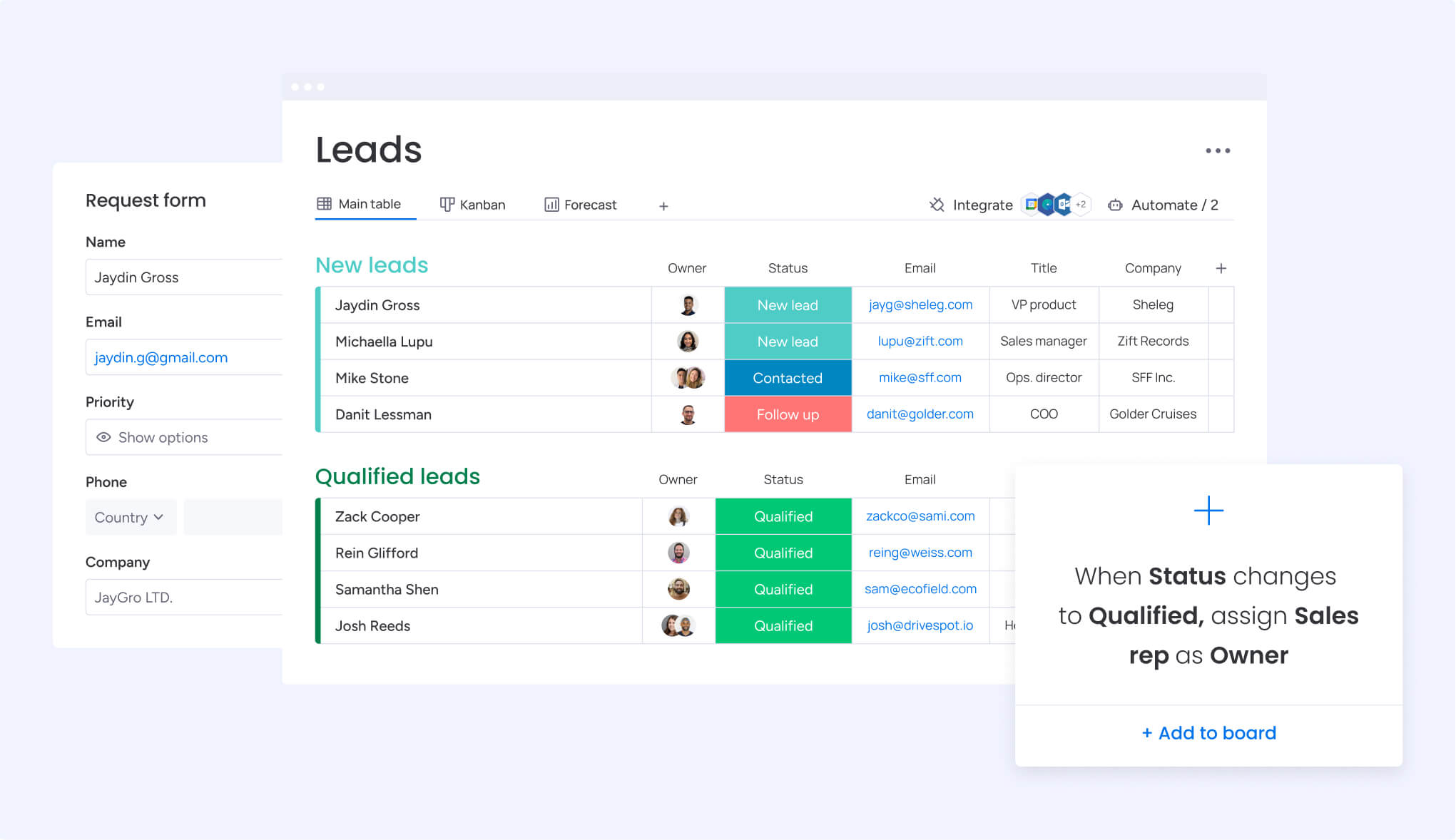
Short sales cycle vs. long sales cycle
Not all sales cycles are created equal. The length of your cycle depends on what you’re selling, who’s buying, and how complex the decision is.
Short cycles work for straightforward purchases with clear value propositions. Long cycles are necessary when multiple stakeholders need to evaluate complex solutions.
Here’s how they compare:
| Factor | Short sales cycle | Long sales cycle |
|---|---|---|
| Timeline | Days to weeks | Months to years |
| Decision makers | 1-2 people | Multiple stakeholders |
| Deal size | Lower value | Higher value |
| Product complexity | Simple solutions | Complex implementations |
| Sales approach | Transactional | Relationship-focused |
Your approach needs to match your cycle length. Short cycles benefit from streamlined processes and automation, while long cycles require patience and relationship nurturing.
How to measure average sales cycle length
Average sales cycle length tells you how long it typically takes to close a deal. This metric helps you use a sales forecast template to identify improvement opportunities.
Calculate it by adding up the total days for all closed deals, then dividing by the number of deals. Track this monthly to spot trends.
Breaking down cycle length by stage reveals where deals spend the most time. Maybe qualification takes two days but contract negotiation takes two weeks — now you know where to focus improvements.
Different customer segments often have different cycle lengths. Enterprise deals naturally take longer than small business sales, so track them separately for accurate insights.
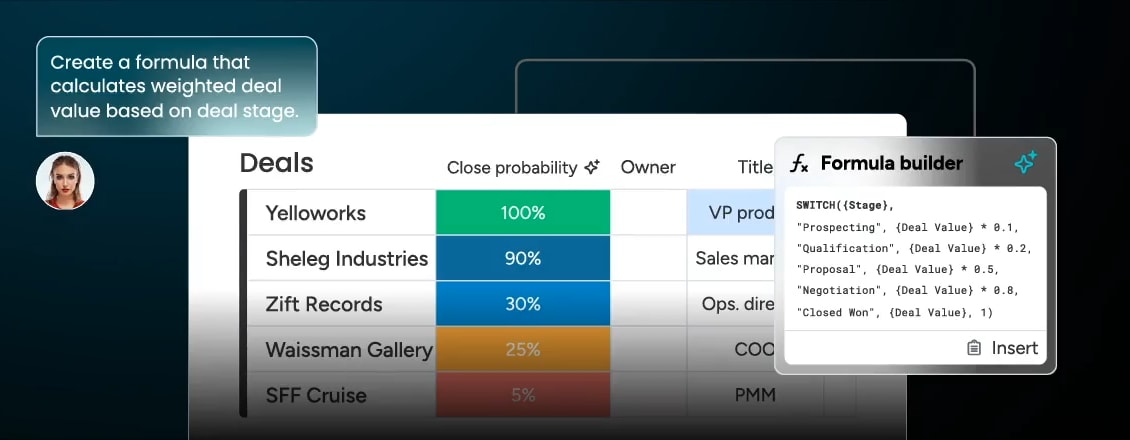
5 tips to manage the full sales cycle
Smart sales management combines the right processes, technology, and team habits. These strategies help you close more deals in less time.
1. Track each stage with real-time data
You can’t improve what you don’t measure. Real-time CRM reporting shows you exactly where deals stand and where problems hide.
Monitor these key B2B sales metrics for each stage:
- Conversion rates: What percentage of deals move forward?
- Time in stage: How long do deals typically spend here?
- Activity levels: Are reps taking enough action to move deals forward?
- Pipeline balance: Do you have enough deals at each stage?
monday CRM’s dashboards visualize all this data automatically. You’ll spot trends and issues before they impact your targets.
2. Leverage automations to reduce manual work
Why waste time on repetitive tasks when sales automation can handle them? Focus your energy on building relationships while technology handles the busywork.
Automation opportunities include:
- Lead routing: Instantly assign new prospects to the right rep
- Follow-up reminders: Ensure every deal stays warm with timely follow-ups
- Data capture: Automatically log emails and calls without manual entry
- Status updates: Keep records current based on activity triggers
The goal is freeing up more selling time, not replacing human connection.
3. Align marketing and sales early
When marketing and sales work together, everyone wins. Alignment creates higher-quality leads and smoother handoffs throughout the cycle.
Build alignment through:
- Shared definitions: Agree on what makes a qualified lead
- Regular feedback: Tell marketing which sources produce the best prospects
- Content collaboration: Create materials that actually help close deals
- Joint planning: Set targets and strategies together
This partnership pays off in shorter cycles and higher close rates.
4. Use AI for faster responses
AI accelerates your sales cycle without sacrificing the personal touch, yet with only 51% of sales professionals currently using AI, there’s a huge opportunity for teams to gain a competitive edge. Think of it as your assistant, handling routine tasks so you can focus on strategy.
AI helps with:
- Email personalization: Create relevant messages at scale
- Lead prioritization: Identify hot prospects automatically
- Content suggestions: Generate proposals and presentations faster
- Response timing: Know when prospects are most likely to engage
monday CRM’s AI blocks make these capabilities accessible without technical expertise. You get the benefits of AI while maintaining control over your sales process.
5. Provide continuous training
Sales skills need constant sharpening, and it’s what employees are asking for—our research shows that 60% of employees believe better training would improve how changes are managed. Regular training keeps your team ahead of changing buyer expectations and market conditions.
Focus training on:
- Stage-specific skills: Master each part of your cycle
- Objection handling: Practice responses to common concerns
- Product updates: Stay current on new features and benefits
- Platform proficiency: Use every capability your CRM offers
The best teams never stop learning and improving.
How AI and CRM transform the selling cycle
When AI meets CRM, the combination creates capabilities that seemed impossible just a few years ago.
- AI analyzes patterns in your sales data to predict which deals will close and which need attention. You’ll know where to focus your efforts for maximum impact.
- Automated workflows handle routine tasks instantly. Lead routing, follow-up scheduling, and data entry happen automatically while you concentrate on selling.
- Personalization becomes scalable when AI suggests the right message for each prospect based on their behavior and characteristics. Every interaction feels custom-crafted.
- Real-time coaching provides suggestions during sales activities. It’s like having a sales mentor available 24/7 to help you make the right moves.
monday CRM brings these AI capabilities to teams of all sizes , from startups to enterprise organizations .
The drag-and-drop, color-coded interface eliminates the learning curve typically associated with powerful software, allowing sales reps to start automating workflows and leveraging AI insights within minutes, not weeks.
You don’t need coding knowledge or technical expertise to set up personalized dashboards, create AI-powered email templates, or build automated follow-up sequences that keep deals moving forward.
This democratization of advanced sales technology means every team member can immediately contribute to shortening your sales cycle, regardless of their technical background.
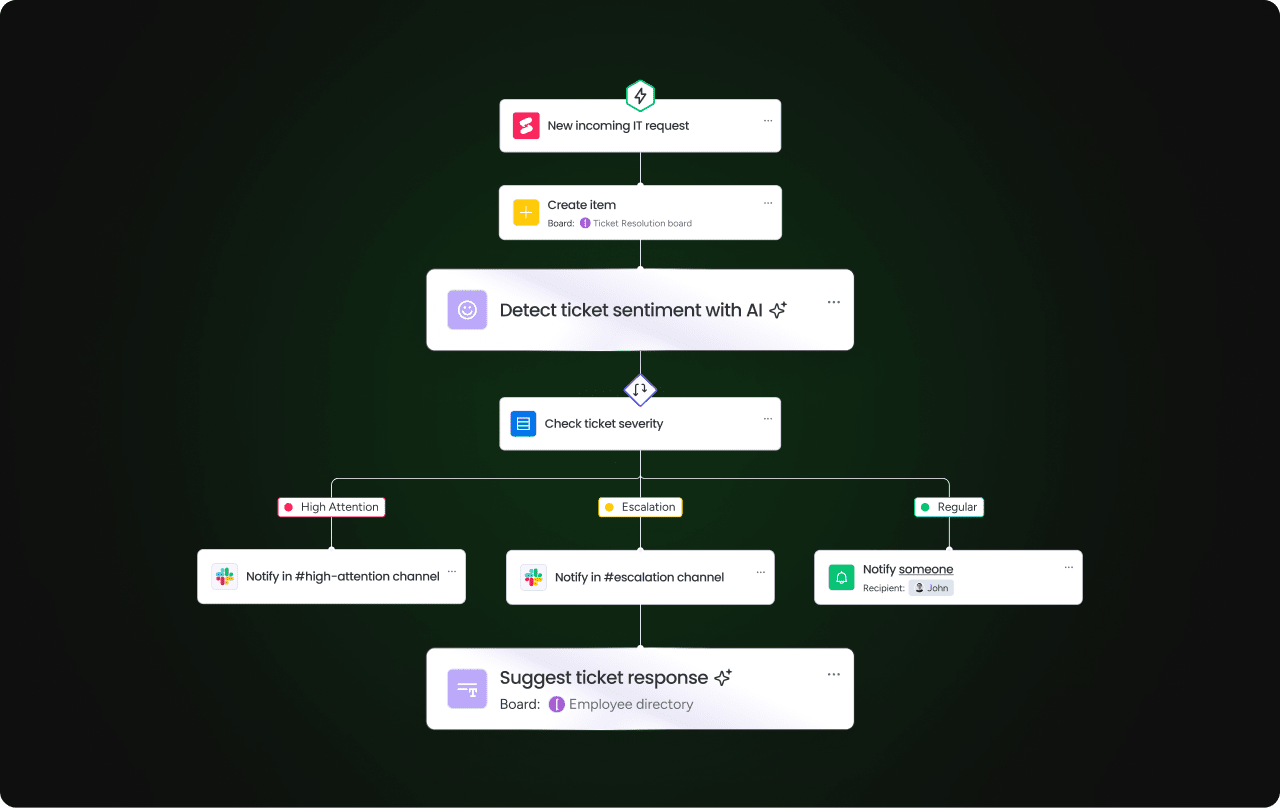
How monday CRM optimizes your sales cycle
monday CRM provides a comprehensive solution designed specifically for sales cycle management:
- Customizable pipelines: Adapt to your unique sales stages and workflows with drag-and-drop simplicity. Whether you follow a traditional 7-stage approach or have industry-specific requirements, monday CRM lets you build pipelines that mirror your actual selling process—not force you into rigid templates.
- Automated workflows: Reduce manual tasks and administrative burden through intelligent automations that trigger based on deal progress. Set up automatic follow-up reminders, stakeholder notifications, and data updates that keep deals moving forward while your team focuses on relationship-building conversations.
- Real-time visibility: Track deal progression and pipeline health instantly with color-coded status indicators and dynamic filtering. See exactly where each opportunity stands, identify potential bottlenecks before they impact revenue, and make data-driven decisions without waiting for end-of-month reports.
- Built-in AI capabilities: Generate personalized outreach and identify high-potential opportunities using AI that learns from your team’s success patterns. monday CRM’s AI analyzes prospect interactions, suggests optimal next steps, and even helps craft personalized messages that resonate with specific buyer personas.
- Intuitive dashboards: Monitor key metrics like conversion rates and time-in-stage through customizable visualizations that transform complex data into actionable insights. Create role-specific views that show reps their individual performance while giving managers the bird’s-eye perspective needed for coaching and forecasting.
- Seamless collaboration: Ensure smooth handoffs between team members throughout the sales journey with contextual commenting, shared workspaces, and integrated communication tools. Eliminate information silos by connecting marketing, sales, and customer success teams on a single platform where everyone sees the complete customer journey.
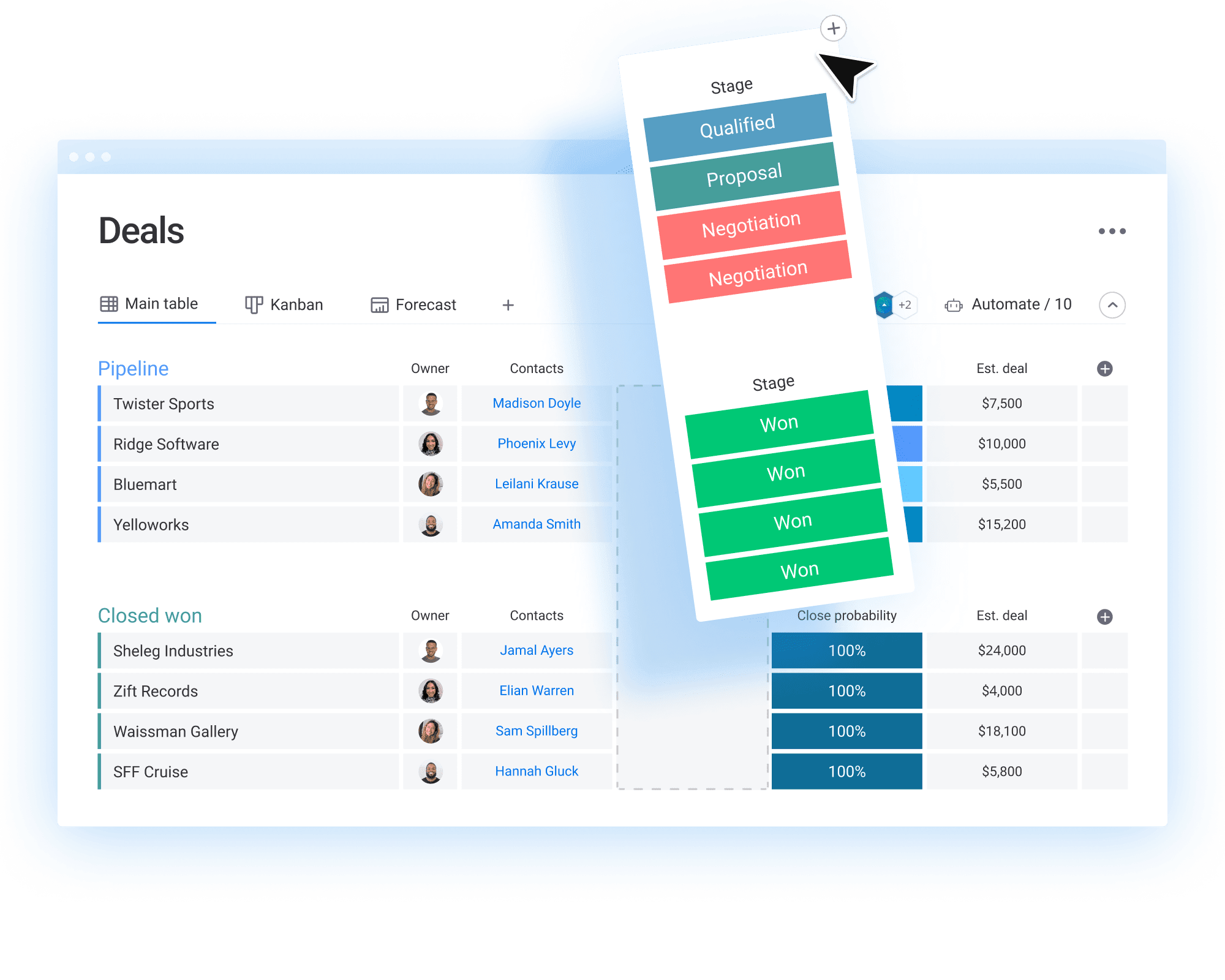
Increase your sales with adaptable platforms
Success in modern sales requires flexibility. Your sales cycle is unique, and your CRM should adapt to how you sell, not force you into a rigid framework.
The right platform grows with your business, supporting everything from quick transactions to complex enterprise deals. AI capabilities accelerate results without replacing the human relationships at the heart of sales.
Teams using adaptable platforms like monday CRM as their sales management software gain the visibility and control needed to hit targets consistently. When your technology matches your sales approach, everything flows more smoothly.
Try monday CRMFrequently asked questions
What are the 7 stages of the sales cycle?
The 7 stages of the sales cycle are prospecting, connecting, qualifying, presenting, resolving objections, closing, and following up. Each stage moves prospects closer to becoming customers through specific actions and outcomes.
What is the difference between a sales cycle and sales process?
A sales cycle outlines the specific stages prospects move through from first contact to purchase. A sales process describes your overall methodology and strategies for selling. The cycle is the "what" while the process is the "how."
How long should a B2B sales cycle typically last?
A typical B2B sales cycle lasts between 3 to 6 months, though this varies widely based on deal size and complexity. Simple products might close in weeks while enterprise solutions can take over a year.
What factors make sales cycles longer or shorter?
Sales cycles get longer with higher prices, more decision-makers, complex products, and heavy regulations. They get shorter with clear value propositions, single decision-makers, and urgent buyer needs.
How can I shorten my sales cycle without rushing buyers?
Shorten your sales cycle by qualifying prospects thoroughly upfront, addressing objections proactively, and using automation for administrative tasks. Focus on understanding buyer urgency and removing unnecessary steps from your process.
What is sales cycle management and why does it matter?
Sales cycle management means tracking, analyzing, and optimizing each stage of your sales process to improve results. It matters because it helps you identify bottlenecks, forecast accurately, and replicate successful approaches across your team.

